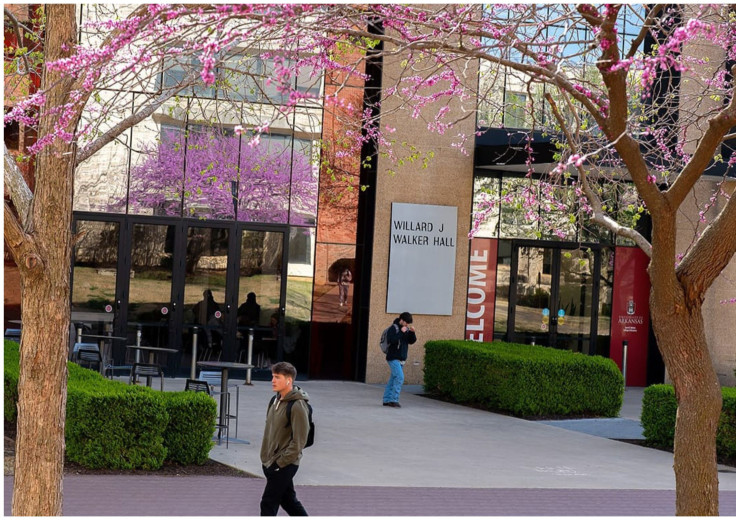Is A Serial Prankster On The Loose? Alarms Raised As 'Active Shooter' Hoaxes Hit Two Universities In A Row

KEY POINTS
- University of Arkansas evacuated after 346 false calls of a gunman across seven campus buildings.
- At least six US universities faced active shooter alerts this week, all later proven false.
- Investigators probing whether a coordinated swatting ring is behind the spree of fake calls.
The University of Arkansas in Fayetteville was thrown into chaos on Monday afternoon, August 25, after a wave of phone calls falsely reporting an active shooter forced evacuations, a campus lockdown and widespread panic. It was one of several false alarms to hit universities across the country in recent days, sparking fears that a serial prankster, or coordinated group, may be behind a spate of terrifying swatting incidents.
Chaos in Fayetteville
According to Assistant Chief Matt Mills of the University of Arkansas Police Department (UAPD), the first call came in around 12:30 p.m. from Mullins Library. Within minutes, dispatchers were inundated with 308 landline calls and 38 emergency 911 calls describing gunshots or a suspect at seven different campus locations, including the Windgate Art and Design District, Pat Walker Health Center, Fine Arts Center, Old Main and Humphreys Hall.
'It's looking as if it was another swatting or hoax call', Mills said at a press briefing. After sweeping the buildings, authorities found no evidence of shots fired, no weapons and no injuries. By 2:45 p.m., the avoid-deny-defend protocols had been lifted, though classes were cancelled for the remainder of the day.
Mayor Molly Rawn called the situation 'deeply troubling', noting that it wasted resources and caused significant distress. 'Whether this was a hoax or a mistake, the consequences are serious', she said. The FBI is assisting in tracking the source of the calls.
Terrifying texts and panic at other schools
The Fayetteville scare was not isolated. Just a few hours earlier — and nearly 700 miles away — campuses in Pennsylvania and Tennessee had also been targeted. Reports of active shooters with assault rifles sent students at Villanova University and the University of Tennessee at Chattanooga running for cover as law enforcement poured onto campuses.
At Villanova, senior Ava Petrosky was singing during an orientation Mass when the panic began. 'Honestly, at that moment I thought, "I'm gonna die"', she told CNN affiliate WPVI. She ran with the crowd and hid.
In Chattanooga, which was celebrating Welcome Week, students received an urgent text message to 'Run. Hide. Fight.' Senior Luke Robbins recalled the terror: 'It was just hectic. It's crazy'. Police armed with rifles directed students to flee across the street as classrooms emptied in seconds.
By the end of the day, at least six universities nationwide had reported active shooter alerts. All proved unfounded. Additional hoaxes were logged at the University of South Carolina and another at Villanova on Sunday.
National Pattern of Swatting
The surge in false reports highlights a worrying trend. Swatting — the deliberate act of making false emergency calls to provoke a heavy law enforcement response — has been tracked by the FBI for two decades. A researcher who studies the phenomenon documented 731 swatting calls at schools and universities in 2023 alone. The Educator's School Safety Network, a nonprofit dedicated to school security, counted more than 446 false active shooter reports during the 2022–2023 academic year.
The problem is compounded by the reality that mass shootings remain a horrific threat in American life. Less than a month ago, a gunman opened fire at the CDC headquarters in Atlanta, forcing a lockdown at nearby Emory University. In late July, a gunman attacked the NFL's New York headquarters in Manhattan, killing four people, including an off-duty police officer. Against that backdrop, students say it is impossible not to take each alert seriously.
'It was a really tough way to start freshman year at college', said Courtenay Harris Bond, who was on Villanova's campus with her son when the alert went out.
Real fear, lasting scars
Even though the reports were false, the fear they created was painfully real. Students at multiple campuses described barricading themselves in bathrooms, knocking over chairs to block doors, and frantically texting loved ones as alarms rang out.
Counseling services have been activated at universities hit by the hoaxes, including Fayetteville, where officials acknowledged the psychological impact. 'The fear you felt in those moments was very real', Mayor Rawn told residents. 'Please take care of yourselves and each other.'
Who is behind the calls?
Law enforcement is now under pressure to determine whether the spate of hoaxes is linked. In previous swatting waves, perpetrators used Voice over Internet Protocol (VoIP) to disguise their locations, often operating from overseas. The FBI has broken up swatting rings in the past, but experts warn the problem is evolving.
What makes the latest series of hoaxes especially chilling is their scale and coordination. From Arkansas to Pennsylvania to Tennessee — and stretching to South Carolina and Arizona — students have endured near-identical scares in just a matter of days.
For now, the perpetrators remain unknown. But with panic sweeping campuses and law enforcement stretched thin, the fear is that unless the culprits are caught, it is only a matter of time before another false alarm plunges a university into chaos — or worse, collides with a real threat.
© Copyright IBTimes 2025. All rights reserved.





















